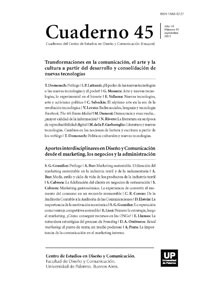Políticas culturales y nuevas tecnologías
Abstract
The following essay aims to explore the formation of three literary blogs and one of them belonging to the art world after the concept of cultural policy held by the anthropologist and philosopher Nestor Garcia Canclini. The article analyze the three examples, seeking for what cultural practices they held in relation
to previous knowledge and practices, how to give visibility to new social actors how create new links in relation to the production, circulation and reception of art and literature, from what conception of culture they work, what aspects could be taken to replicate institutions whether public, private or third sector.
We believe that the exploration and analysis of these experiences contributes on the one hand, to the study of the relationships between literature, arts and new technologies but also to the study of new features characteristic of the network that could be implemented in other areas in which they think, designed and carried out cultural policies.
References
AA.VV. (2004). Gestión cultural, identidad y Estado. Buenos Aires: Instituto Cultural.
Bayardo, R (2002). Problemas de las políticas culturales, la economía cultural y el financiamiento de la cultura. Ponencia presentada en el ciclo de seminarios internacionales sobre pensamiento y gestión cultural. Buenos Aires: Bolsa de comercio.
Entel, A. (1993). Aproximaciones a los Estudios Culturales. Buenos Aires: C.E.C.So de la UBA.
Foucault, M. (1995). Discurso, poder y subjetividad. Buenos Aires: El cielo por asalto.
García Canclini, N. (1995). Consumidores y ciudadanos. Conflictos multiculturales de la globalización. México: Grijalbo
(1987). Políticas culturales en América Latina. México: Grijalbo.
Olmos, H. A. (2004). Políticas culturales y gestión. En El gestor cultural. Ideas y experiencias para su capacitación. Buenos Aires: Ediciones CICCUS -La Crujía.
Los autores/as que publiquen en esta revista ceden los derechos de autor y de publicación a "Cuadernos del Centro de Estudios de Diseño y Comunicación", Aceptando el registro de su trabajo bajo una licencia de atribución de Creative Commons, que permite a terceros utilizar lo publicado siempre que de el crédito pertinente a los autores y a esta revista.


